Starting with July 2021, BetaFPV introduced a new product line based on LoRa powered ExpressLRS radio communication. Their offer ranges from radio receivers and transmitters to flight controllers. You can opt from 2.4GHz, 915 MHZ, or 868 MHz systems according to your needs and RF local regulations. While 900MHz systems allow longer-range and better penetration (for Bando – flying through buildings), the 2.4GHz frequency is more appropriate for racing and freestyling due to the faster response rate and lower latency. Also, low-frequency devices can have longer talk times and require less power than high-frequency devices. If size matters, 2.4GHz requires smaller antennas than 900Mhz.
ExpressLRS (ELRS) is an open-source RC link for various applications, including drone communications. ELRS supports a wide range of hardware platforms and 900 MHz and 2.4 GHz frequency options. ExpressLRS uses LoRa modulation and reduced packet size in order to achieve the best results in terms of class range and latency, compared to current commercial offerings. LoRa is not a new technology, the concept was born in 2015 to provide long-range communication for low-power IoT (Internet of things) devices/sensors.
ELRS aims to achieve the best possible radio link performance for both latency and range. It supports telemetry as an optional feature (with BetaFlight LUA script). What’s more important for drone users is that the ExpressLRS ecosystem claims to be more cost-effective than TBS Crossfire and Frsky R9M.

BetaFPV ExpressLRS products review
Disclosure: I received these ExpressLRS electronics as part of a product review collaboration with BetaFPV. Technical specs and quality may vary according to the manufacturer’s reliability, so I cannot guarantee that you will get identical products, as seen in my article.
BetaFPV sent me an ELRS Nano TX unit, an additional T-type Moxon antenna, two Nano RX modules, and an F4 AIO flight controller with a built-in ExpressLRS radio receiver. All for 2.4GHz band.
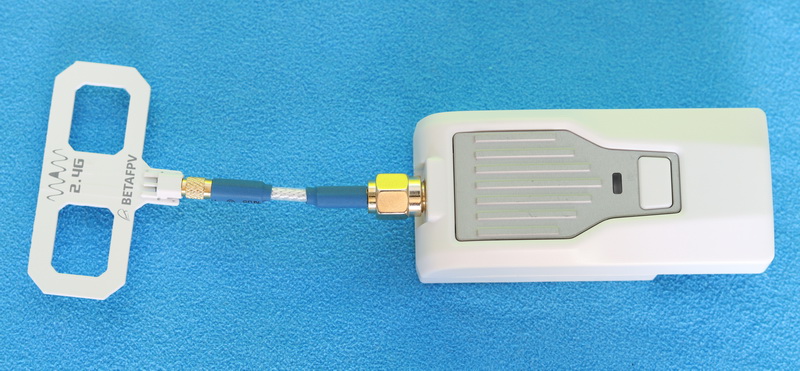
1. BetaFPV ExpressLRS Nano TX
I will start with the Nano TX module, which is an external transmitter module that can be attached to the back of your existing transmitter. According to BetaFPV, their module is compatible with Frsky Taranis X-Lite, Taranis X9D Lite, T-Lite, and TBS Tango 2 bays. Personally, I will test it with an OpenTX enabled Jumper T-Lite remote controller. The module has two versions: 915MHz/868MHz and 2.4GHz. All variants can be ordered for $39.99.
ExpressLRS uses the popular Crossfire serial protocol (aka CRSF protocol) to communicate between the radio transmitter and the Nano TX module.
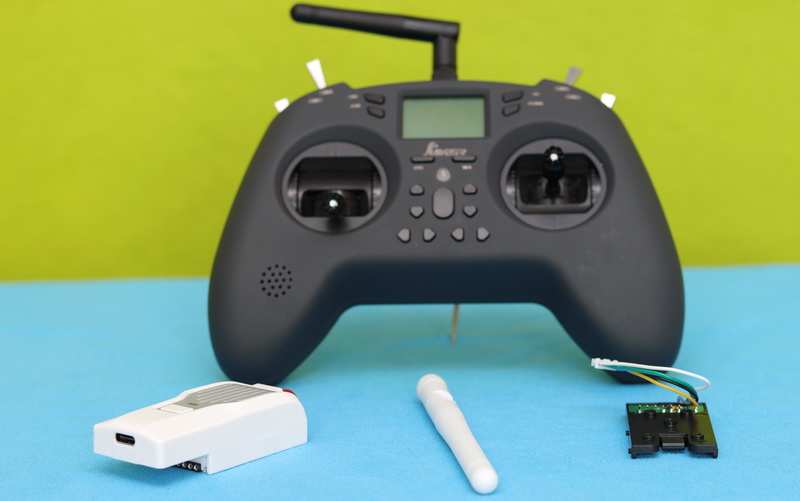
The BetaFPV ExpressLRS Nano TX module roughly measures 40x50x100mm and weighs 77grams without the antenna. It comes with two types of antennas, a rubber ducky and a Moxon one (aka T-type). In addition to the heating, there is a status RGB LED and Bind/TX power button on the front panel. The transmission power can be toggled between 100mW (blue), 250mW (purple), and 500mW (red).
BetaFPV provides an online instruction manual that explains the basic configurations of the Nano TX. Note: Never power on the module without an antenna connected!
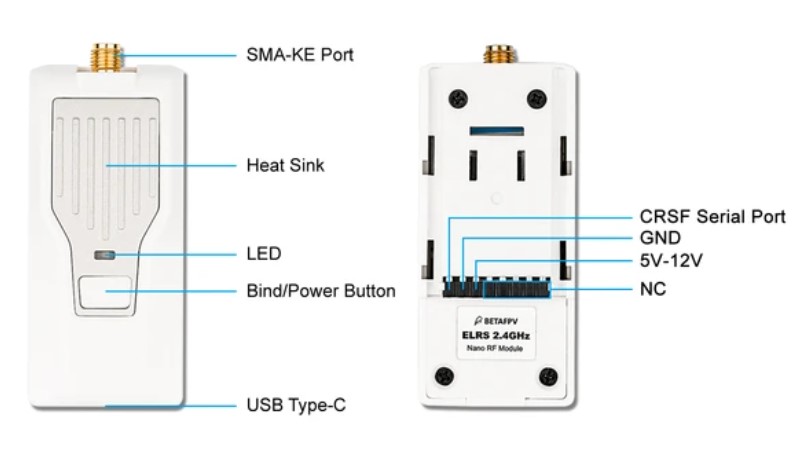
ExpressLRS Nano TX specifications
- Packet refresh rate:
- 25Hz/50Hz/100Hz/200Hz (915MHz/868MHz)
- 25Hz/50Hz/150Hz/250Hz/500Hz (2.4GHz)
- RF output power: 100mW/250mW/500mW
- Frequency bands
- Nano RF Module 2.4G version: 2.4GHz ISM
- Nano RF Module 915MHz/868MHz version: 915MHz FCC/868MHz EU
- Input voltage: 5V~12V
- USB port: Type-C
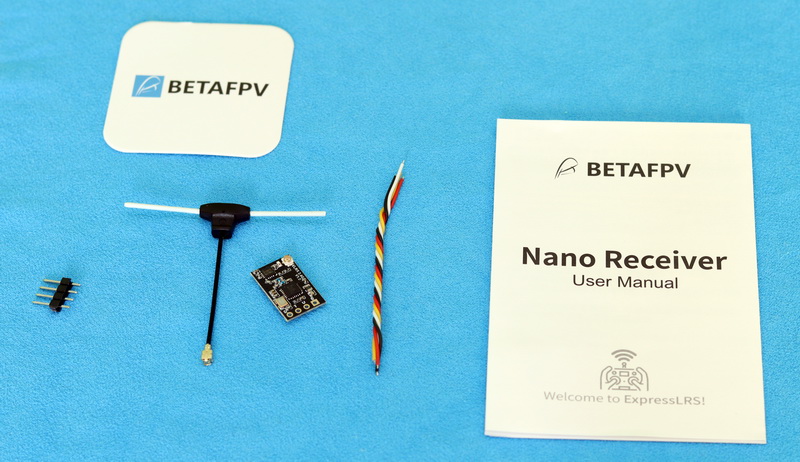
2. BetaFPV ExpressLRS Nano RX
BetaFPV ELRS Nano RX radio receiver measures just 12x19mm and weighs less than 1 gram. It is built around the ESP8285, a very popular coin-sized SoC (System on Chip). The Nano RX has an onboard status LED, WIFI connectivity, and a firmware upgrade button. The included T-type antenna connects to the board via an IPXE MHF socket. The bag includes connection wires and a 4pin header if you prefer using plugs instead of soldering. BetaFPV also provides two shrink tubes in the bag for short circuit protection.

While FrSky radio receivers use only one wire to communicate with the flight controller, the BetaFPV Nano RX uses two: RX and TX. The module requires a 5V input voltage.
The Nano RX frequency needs to be matched with the Nanot TX module. You can opt from 2.4GHz, 915MHz, and 866MHz. All versions are available for $19.99 at BetaFPV.
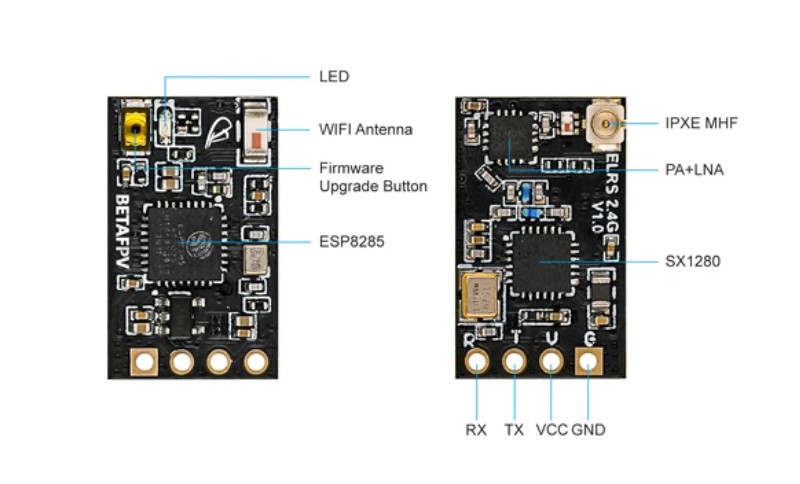
ExpressLRS Nano RX specifications
- Frequency bands:
- Nano receiver 2.4G version: 2.4GHz ISM
- Nano receiver 915MHz/868MHz version: 915MHz FCC/868MHz EU
- Antenna connector: IPEX MHF
- Telemetry power: 20dbm
- Size: 12x19mm
- Weight: 0.7g (receiver only)
3. BetaFPV Moxon antenna for ExpressLRS
The Moxon antenna can be purchased in a package of two for $14.99 or in a bundle with the Nano TX module. Like the other parts of the BetaFPV ExpressLRS ecosystem, it is available in 3 RF versions (2.4GHz, 915MHz, and 866MHz). It comes packed with a small extension cable (SMA to MMCX), this way can be used with TX and RX modules.
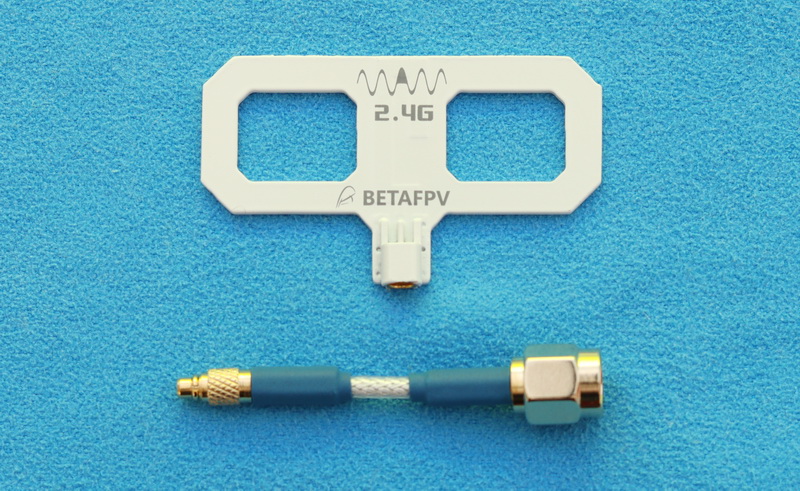
915MHz and 866Mhz versions are visibly larger than the 2.4GHz. The T-shape design provides higher directional gain compared to rod antennas.
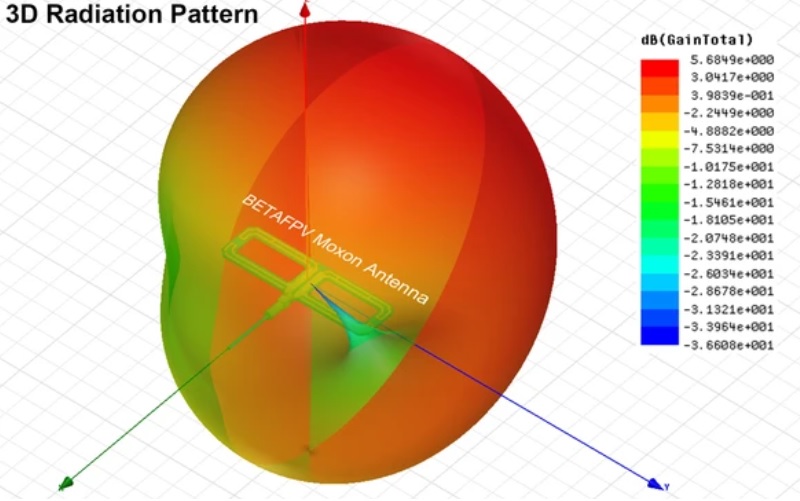
BETAFPV Moxon Antenna specifications
- Coaxial cable length: 49mm(2.4G)/72mm(915M/868M)
- Connector: SMA Male
- Gain:
- 5.6dBi(2.4G)
- 5.7dBi(915M)
- 5.7dBi(868M)
- VSWR:
- <2.0(2.4G)
- <1.5(915M)
- <1.5(868M)
- Suggested for: 2.4G/915MHz/868MHz TX and RX modules
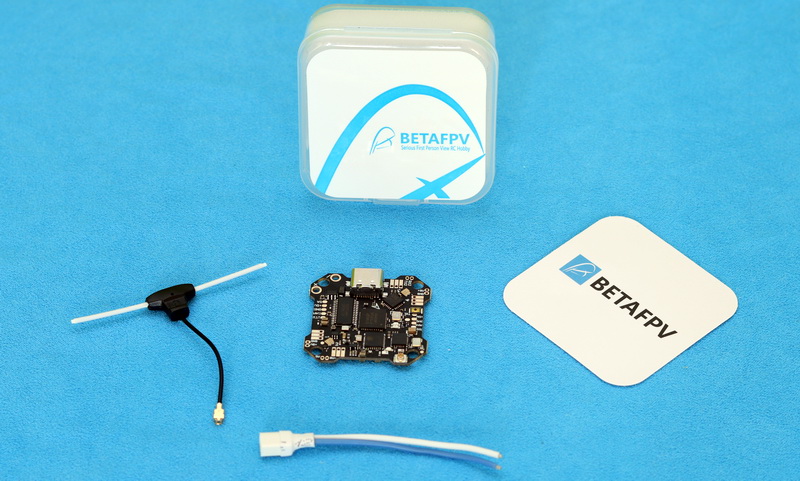
4. BetaFPV F4 AIO flight controller with built-in ELRS radio receiver
The BetaFPV F4 AIO flight controller with integrated 2.4GHz ELRS radio receiver can be purchased for $44.99 -this price includes a 2.4GHz dipole T antenna, BT2.0 battery connector, and mounting accessories (Anti-vibration rubber dampers and screws). The BetaFPV HX115 LR Toothpick style FPV drone comes with this ELRS FC installed and pre-configured.
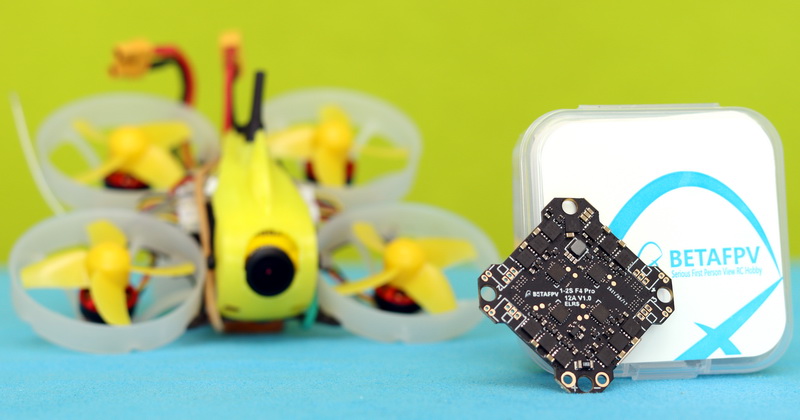
With a 29x29mm mounting pattern, it can be installed on small-size Whoop and Toothpick style drones. The flight controller can be powered with 1S batteries (450mAh 30C recommended) and it has an integrated 12A 4in1 ESC. It has a USB Type-C port for firmware upgrade and configuration. The board accepts an external buzzer and RGB LED.

BetaFPV ExpressLRS F4 AIO FC specifications
- CPU: STM32F411CEU6 (100MHZ )
- Six-Axis: MPU6000 (SPI connection)
- Firmware version: betaflight_4.2.0_STM32F411
- Built-in ELRS 2.4GHz radio receiver
- Integrated 12A ESC
- 12A continuous and peak 25A current
- ESC firmware: Z_H_30_REV16_7.HEX
- Signal support: D-shot150, D- shot300, D-shot600, Oneshot125, Multishot, PWM
- Built-in BetaFlight OSD (STM32 controls OSD chip over SPI in DMA mode)
- USB Port: Type-C firmware/configuration port
- Mounting Hole Size: 29mm x 29mm (suitable for whoop pattern mounting hole)
- 1S LIPO battery compatible (BT2.0 connector);
- Weight: 4.74 grams.

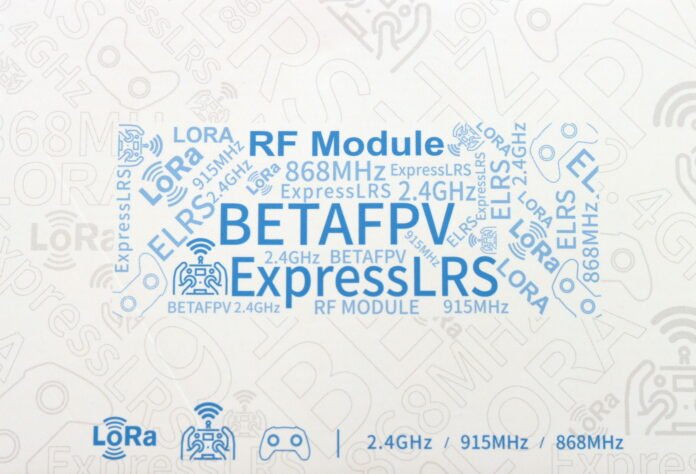
I just flashed the BetaFPV Nano ELRS RX with the latest ExpressLRS 3.3 and no output so I went back to 3.12
I think the 3.3 comes with “Model Match” enabled by default, you need to disable it.
Good luck!
Which is the best antenna for the BetaFPV NANO TX module?
I can’t flash new firmware in the BetaFPV Nano TX module via USB. Any alternative?
You can try via WIFI. You should be able to connect to the Nano TX as to a WIFI router than a webpage will popup where you can upgrade the firmware. Good luck!
Hi, I want to buy ELRS Nano module for my Tango2 transmitter. Is it compatible?
BetaFPV F4 ELRS V2 now supports 2s LIPOs as well!
Can I use Happymodel ExpressLRS antennas with BetaFPV RX modules?
Visitor Rating: 3 Stars
Hello!
I tested it today. 16km at 10mW. No Failsafe. Very cool!
Is it compatible with the new FLYWOO ExpressLRS EL24E / EL24P?
Hey would anyone know who ordered from BetaFPV how long it takes in shipping to get to the UK?
Done. I converted all my drones to Elrs. Goodbye FrSky!
With the BETAFPV Micro-Nano adapter you can use the Nano TX with much more transmitter
So I’m about to build my first fpv drone and was wondering what all you experienced with the new ExpressLRS radio system. Is it stable for long rage?
Any opinions are appreciated!
ExpressLRS is designed for long-range, test videos shows 30-35km flights
The two connector points on the Moxon antenna can potentially reduce its efficacy!
I love ExpressLSR. I can fly as far as my batteries will take me. No failsafe needed
Looking to test EXPRESSLRS. I have a jumper t 18 Pro controller. It will work with the betafpv nano tx?
Visitor Rating: 5 Stars
Visitor Rating: 3 Stars
Visitor Rating: 4 Stars